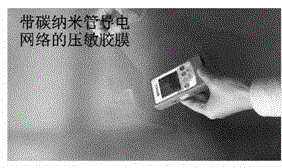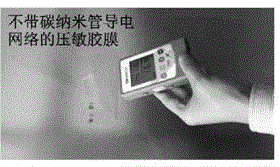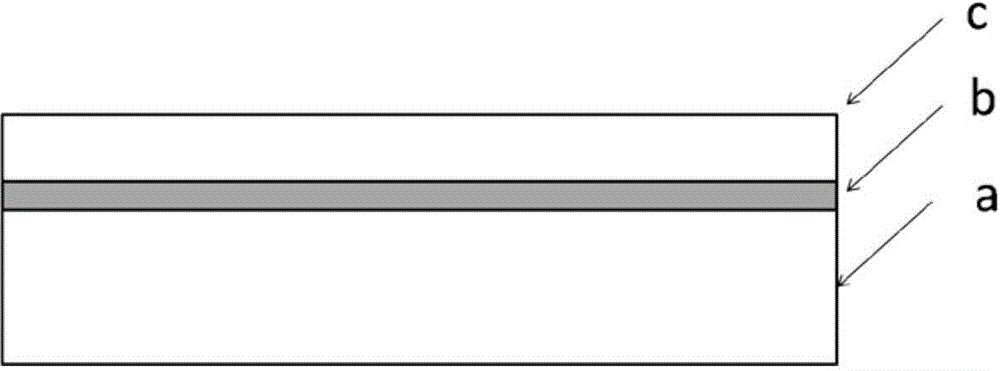Carbon-nanotube-based transparent antistatic pressure-sensitive adhesive structure and application thereof
A carbon nanotube, anti-static technology, applied in the direction of adhesives, film/flake adhesives, etc., can solve problems such as unfavorable product detection, waste of conductive materials, disadvantages, etc., to achieve excellent anti-static ability, protection, safety and cleanliness , the effect of large application market
- Summary
- Abstract
- Description
- Claims
- Application Information
AI Technical Summary
Problems solved by technology
Method used
Image
Examples
Embodiment 1
[0045] 1. Preparation of carbon nanotube dispersion: Weigh 1g of multi-walled carbon nanotubes and 2g of SDBS (sodium dodecyl benzene sulfonate, CAS No. 25155-30-0) into 1L of water, and ultrasonicate the system for 30min with a cell pulverizer , and then transferred to a satellite ball mill at a speed of 600 rpm for high energy ball milling for 2 hours. The viscous liquid obtained was filtered through a coarse sieve to remove the zirconium beads, and then centrifuged at 10,000 rpm for 10 minutes in a high-speed centrifuge to remove the precipitate to obtain a carbon nanotube dispersion.
[0046] 2. Preparation of carbon nanotube coating solution: add 20g of SDS (sodium dodecyl sulfate) to the carbon nanotube dispersion solution, and stir with a magnetic stirrer to dissolve the SDS quickly to obtain a viscous dispersion system.
[0047] 3. After the 50μm thick PET substrate is glued to the surface dust by double-sided sticky rollers, it enters the dimple coating unit. The temp...
Embodiment 2
[0051] 1. Preparation of carbon nanotube dispersion: Weigh 1g of double-walled carbon nanotubes and place them in 1L of DMF (dimethylformamide). Ultrasonicize the system for 100min with a cell pulverizer, then transfer it to a satellite ball mill for High energy ball milling at 600rpm for 5h. The viscous liquid obtained was filtered through a coarse sieve to remove the zirconium beads, and then centrifuged at 10,000 rpm for 10 minutes in a high-speed centrifuge to remove the precipitate to obtain a carbon nanotube dispersion.
[0052] 2. After the 50μm thick PET substrate is glued to its surface by double-sided dust-adhesive rollers, it enters the slit coating unit. The temperature of the oven is set at 160°C, and the machine speed is adjusted to 30m / min, and carbon nanometers are coated on the PET surface. tube conductive layer. A transparent carbon nanotube conductive coating is obtained by drying at a high temperature, and tests show that its structure is similar to Embodi...
Embodiment 3
[0056] 1. Preparation of carbon nanotube dispersion: Weigh 1g of single-walled carbon nanotubes and place them in 1L of deionized water. Ultrasonicize the system for 30min with a cell pulverizer, and then transfer it to a satellite ball mill for high-energy ball milling at 600rpm for 1h. . The viscous liquid obtained was filtered through a coarse sieve to remove the zirconium beads, and then centrifuged at 10,000 rpm for 10 minutes in a high-speed centrifuge to remove the precipitate to obtain a carbon nanotube dispersion.
[0057] 2. Preparation of carbon nanotube coating solution: add 20g of SDS (sodium dodecyl sulfate) to the carbon nanotube dispersion solution, and stir with a magnetic stirrer to dissolve the SDS quickly to obtain a viscous dispersion system.
[0058] 3. After the 30μm thick PET substrate is glued to the surface dust by the double-sided dust-adhesive roller, it enters the dimple coating unit. The oven temperature is set to 120°C, and the machine speed is a...
PUM
| Property | Measurement | Unit |
|---|---|---|
| thickness | aaaaa | aaaaa |
| porosity | aaaaa | aaaaa |
Abstract
Description
Claims
Application Information
 Login to View More
Login to View More - R&D
- Intellectual Property
- Life Sciences
- Materials
- Tech Scout
- Unparalleled Data Quality
- Higher Quality Content
- 60% Fewer Hallucinations
Browse by: Latest US Patents, China's latest patents, Technical Efficacy Thesaurus, Application Domain, Technology Topic, Popular Technical Reports.
© 2025 PatSnap. All rights reserved.Legal|Privacy policy|Modern Slavery Act Transparency Statement|Sitemap|About US| Contact US: help@patsnap.com



